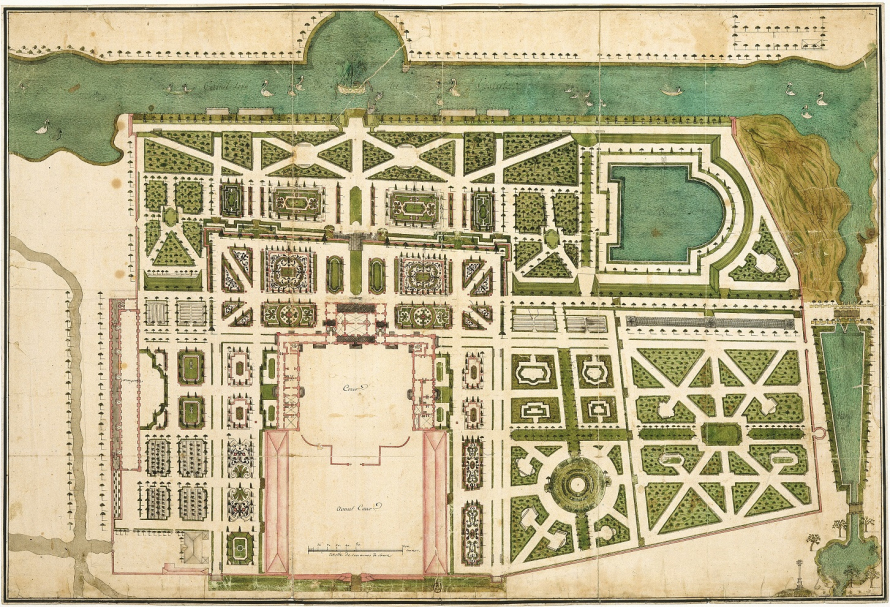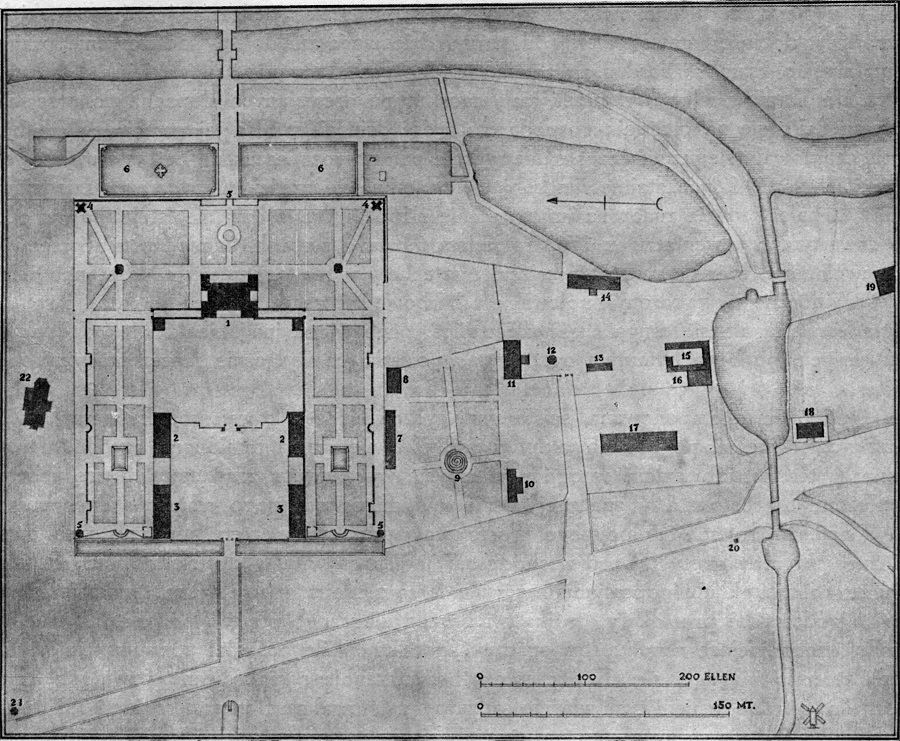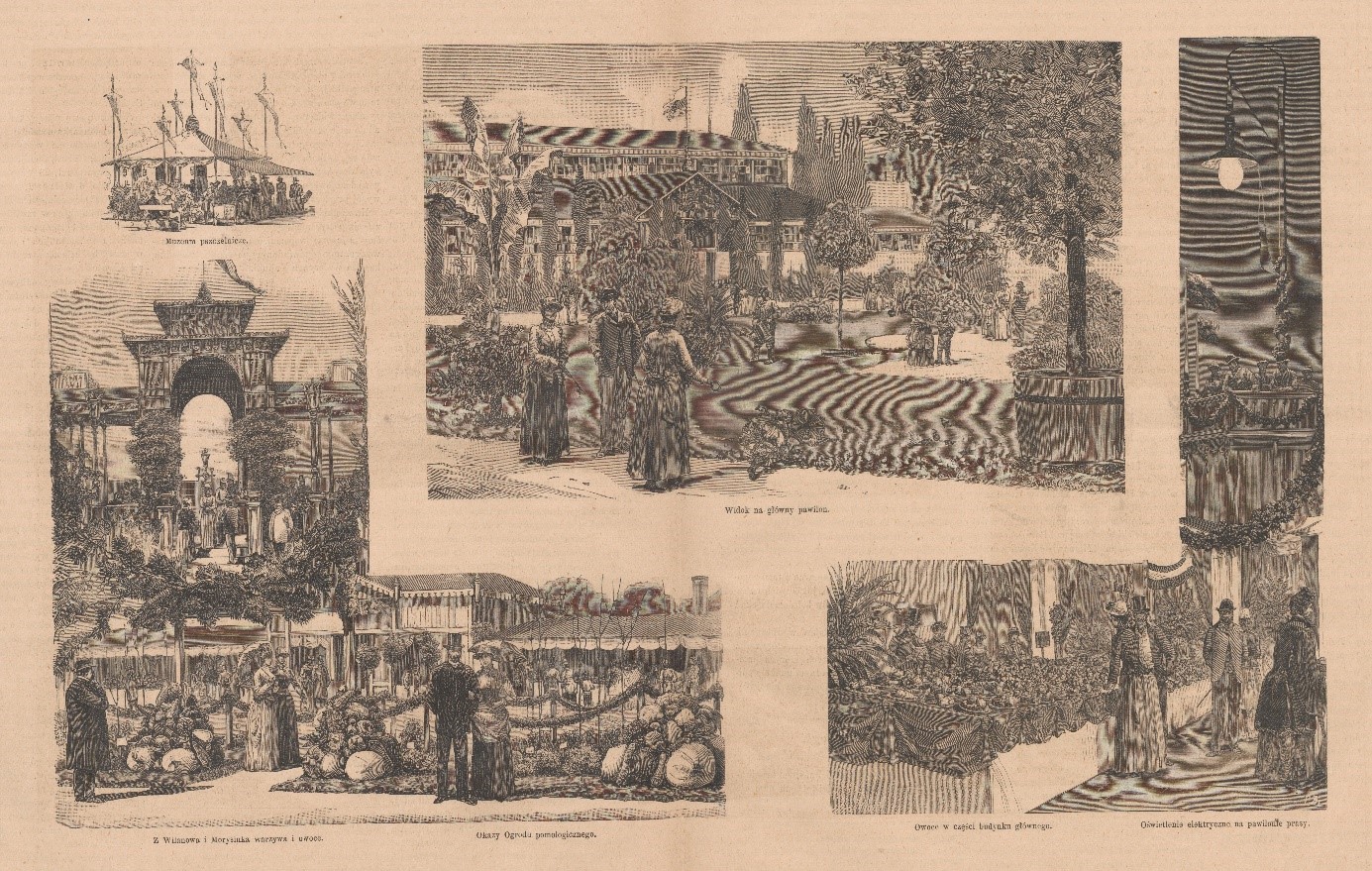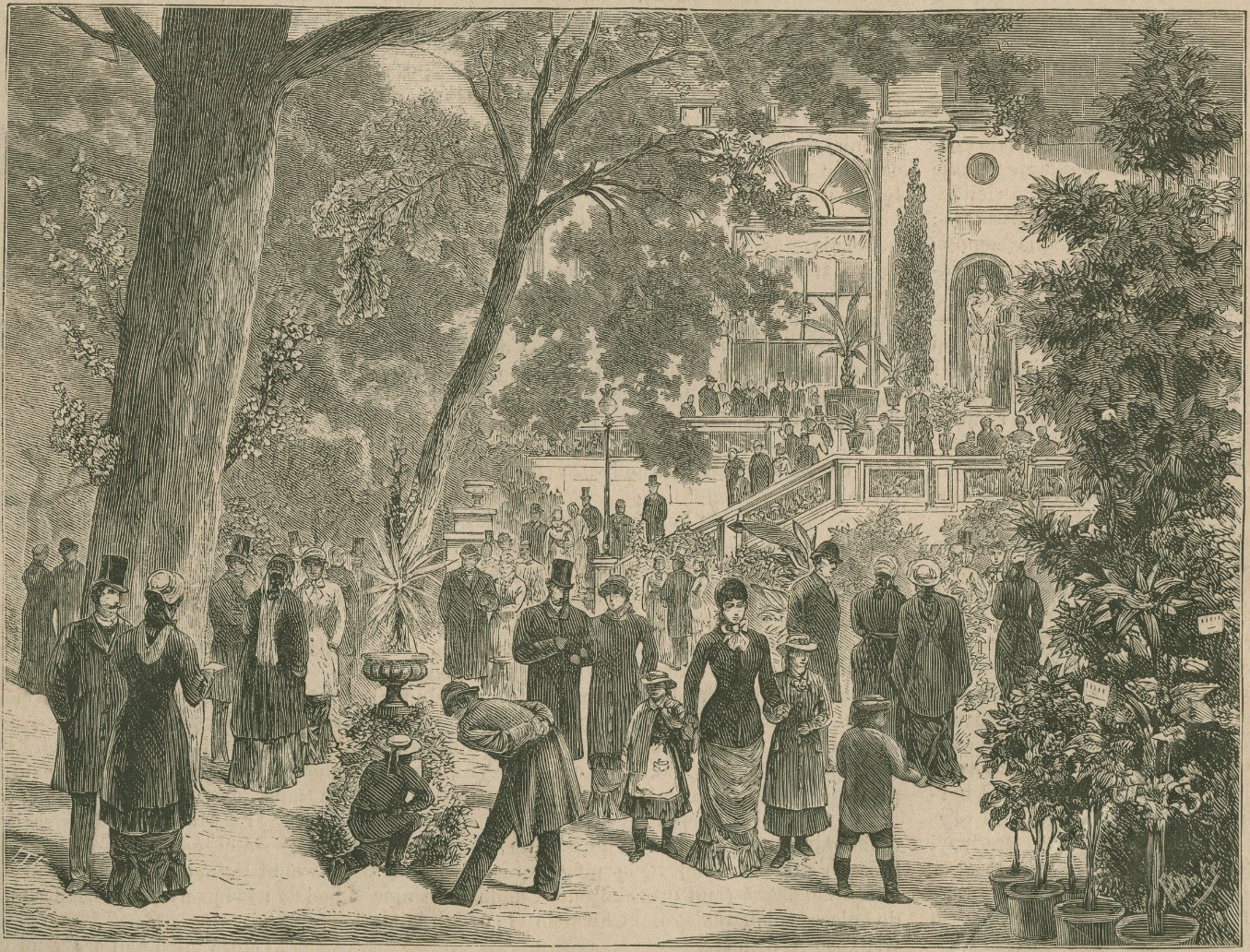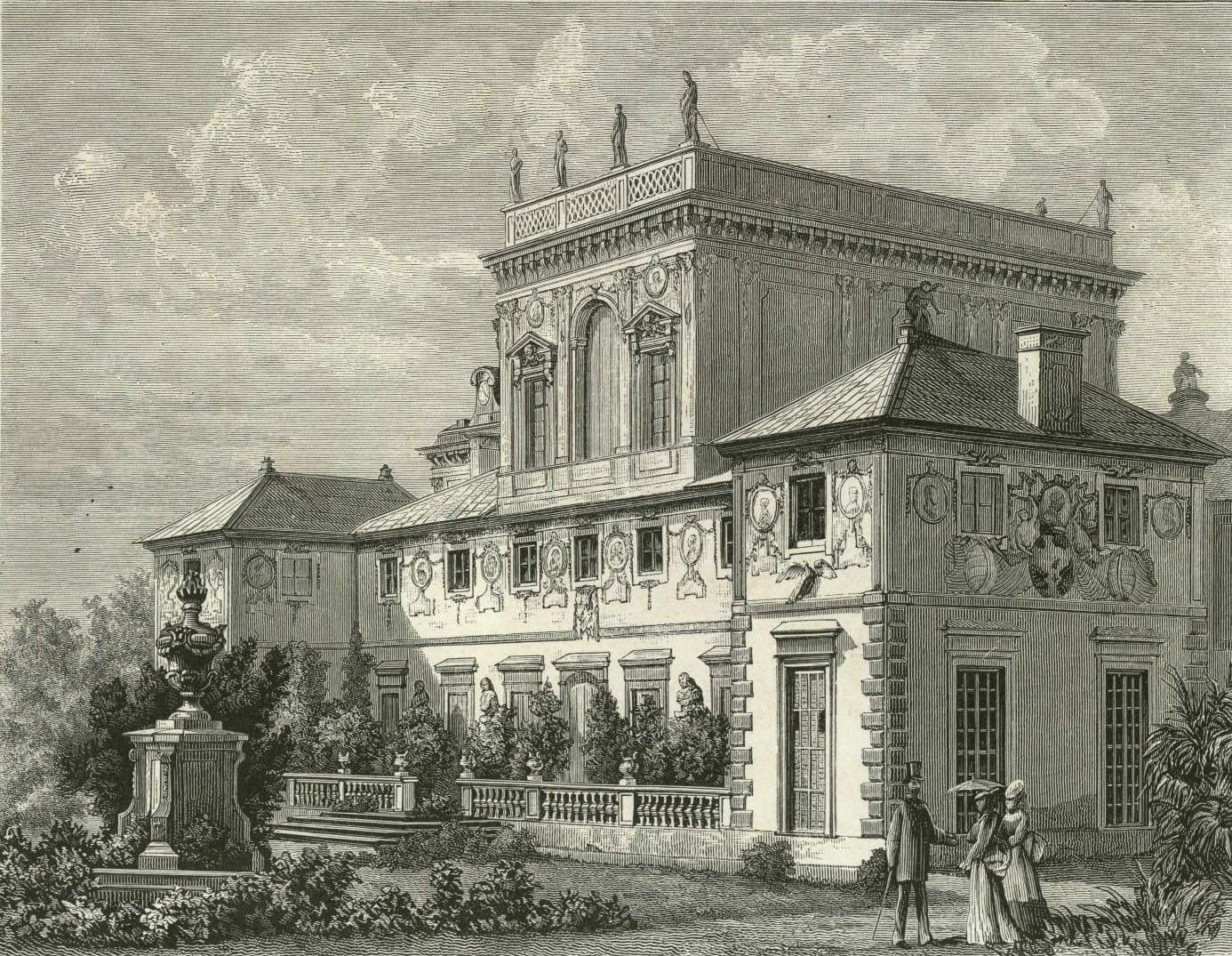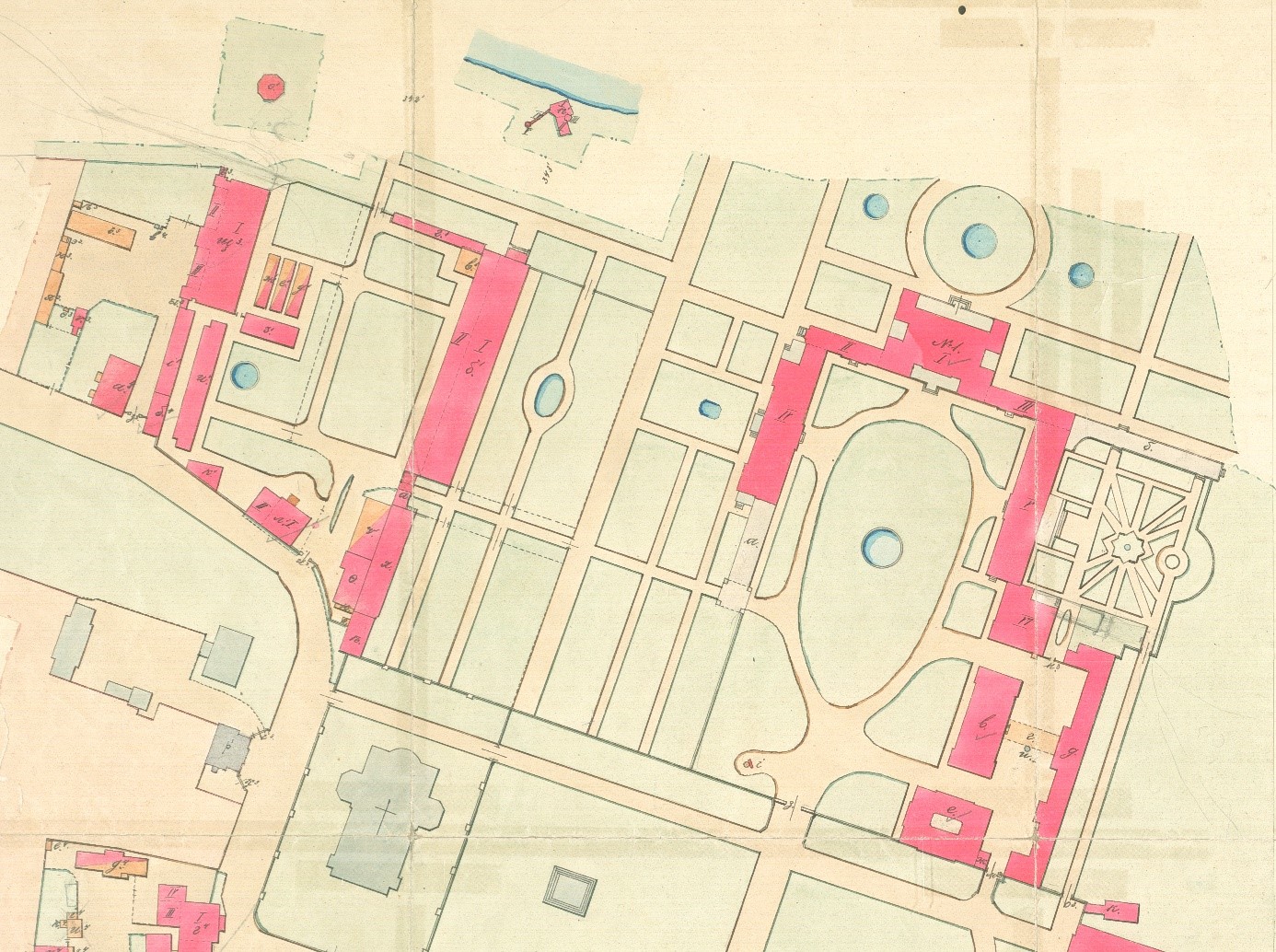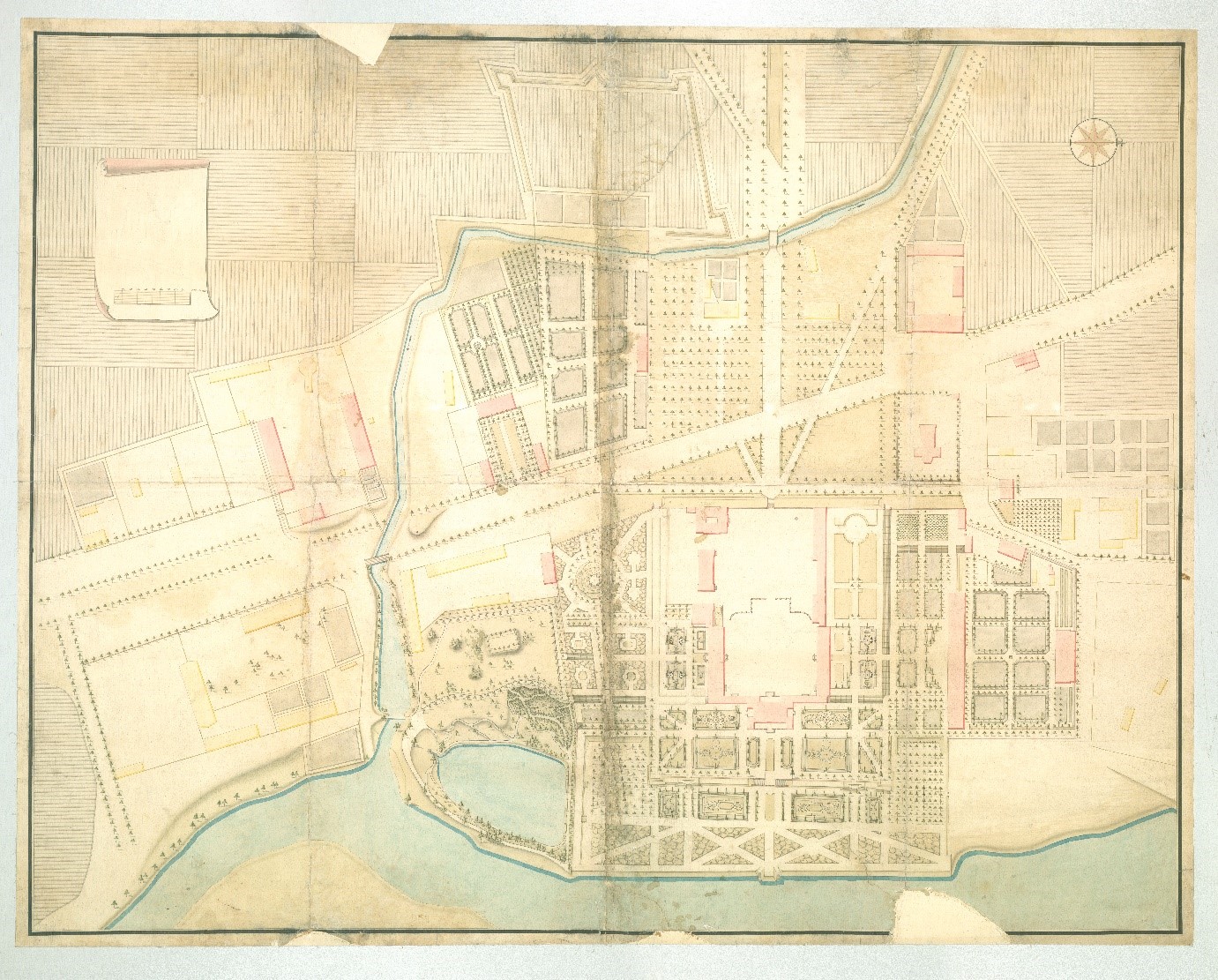Elżbieta Sieniawska’s Wilanów exotic plant collection in 1729
Early 18th century was a time of rapid growth for the Wilanów exotic plant collection. The Wilanów owner at the time, Cracow castellaness Elżbieta Sieniawska [1], financed the reconstruction of the orangery into a brick-walled structure designed by Giovanni Spazzio [2]. The architect directed the work in 1725–1726, and after his death the construction was completed by Giuseppe Giacomo Fontana [3]. The magnate also expanded the historical plant collection of King Jan III. According to the register compiled not long after her death on 27 June 1729, Wilanów housed 830 specimens of aromatic shrubs and herbs, citrus trees and other decorative and exotic plants. The collection was curated by Johann Georg Zeidler, a Saxony-born horticulturist employed back in the time of prince Konstanty Sobieski.
Said register of trees and shrubs is part of The Inventory of the Wilanów Italian Garden…, now kept at the Princes Czartoryski Library in Cracow. The manuscript contains an exceptionally precise list of plants exhibited at the orangery, and of those grown in the fig house soil and in the garden. Citruses were the most numerous in the former group, numbering as many as 305 specimens. The register listed: 6 bitter orange trees (Citrus × aurantium L.), 1 full-flowered orange trees (Citrus × aurantium flore pleno L.), 5 bergamot orange trees (Citrus × bergamia [Risso] Risso & Poit.), 3 pomelo trees (Citrus grandis [L.] Osbeck), also called “paradise apples” in the past, and 242 other orange trees. These may have also included species known in the contemporary Commonwealth: myrtle-leaved orange tree (Citrus × myrtifolia [Ker Gawl.] Raf.) and sweet orange (Citrus × sinensis [L.] Osbeck), mandarine (Citrus × reticulata Blanco), as well as trifoliate orange (Citrus trifoliata L.). The register also noted: 7 lemon trees (Citrus × limon [L.] Osbeck), 7 citrons (Citrus medica L.), as well as 34 large and small lemon trees. These may have been lemons and citrons, as well as contemporarily known key lime (Citrus × aurantiifolia [Christm.] Swingle) or lumia (Citrus × lumia Risso).
The Wilanów orangery collection also housed other exotic plants. Jasmines formed a major group among them. The 47 white-flowered specimens included Spanish jasmine (Jasminum grandiflorum L.) or common jasmine (Jasminum officinale L.), and the 11 yellow-flowered ones were Italian jasmine (Chrysojasminum humile [L.] Banfi) or winter jasmine (Jasminum nudiflorum Lindl.). There was also 1 Arabian jasmine (Jasminum sambac [L.] Aiton) in the collection, which bears navy blue fruits. The enigmatic single specimen of „Terkinuz Gdanska” was most likely the Sicilian sumac (Rhus coriaria L.), which was historically referred to as “Rhus terginus”. The register further lists: 88 bay laurel trees (Laurus nobilis L.), 3 boxwood trees (Buxus sempervirens L.), 9 Mediterranean cypress trees (Cupressus sempervirens L.), 11 Spanish gorse trees (Genista hispanica L.), 16 Yucca gloriosa bushes (Yucca gloriosa L.), 23 pomegranate bushes (Punica granatum L.) and 159 rosemary bushes (Salvia rosmarinus Spenn.). 7 trees, whose names are written illegibly, remain unidentified.
Herb plants included 9 wallflowers (Erysimum × cheiri [L.] Crantz), 44 clove pinks (Dianthus caryophyllus L.) and 75 specimens of a “rose herb”. These may have included many species grown in the Commonwealth in the 17th and 18th centuries, such as basil (Ocimum basilicum L.), St. John's wort (Hypericum perforatum L.), hyssop (Hyssopus officinalis L.), cumin (Carum carvi L.), coriander (Coriandrum sativum L.), valerian (Valeriana officinalis L.), marjoram (Origanum majorana L.), lovage (Levisticum officinale W.D.J.Koch), lemon balm (Melissa officinalis L.), peppermint (Mentha × piperita L.), borage (Borago officinalis L.), chamomile (Matricaria chamomilla L.), sage (Salvia officinalis L.), and thyme (Thymus vulgaris L.).
393 bushes of common grape vine (Vitis vinifera L.), as well as 34 apricot trees (Prunus armeniaca L.) and 22 peach trees (Prunus persica [L.] Batsch) also grew in the Wilanów gardens. 32 almond trees (Prunus amygdalus Batsch), 9 white mulberry (Morus alba L.) or black mulberry trees (Morus nigra L.), as well as 48 fig trees (Ficus carica L.) were grown in the fig house.
[1] Elżbieta Helena Sieniawska née Lubomirska (born ca. 1669, died 21 March 1729) – Polish aristocrat, wife to the Voivode of Bełż and Grand Crown Hetman Adam Mikołaj Sieniawski, owner of the Willanów palace from 1720 to 1729.
[2] Giovanni Spazzio (died 29 July 1726 in Wilanów) – architect from Italy. Designed and conducted the construction of numerous sacral and secular buildings, including the palaces in Wilanów, Łubnie, Oleszyce and Wysock.
[3] Giuseppe Giacomo Fontana (born 21 June 1676 in Mendrisio, died after 1738) – architect from Italy. Was a student of Giovanni Spazzio and participated in the implementation of his designs. Authored the designs for the Bieliński palaces in Warsaw and Otwock Wielki, the Kozłówka palace and the Wilanów palace.
This text is part of the implementation tasks of the Author’s doctoral thesis Technical, aesthetic and management standards of restoring an exotic plant collection in historic gardens exemplified by the Wilanów residence, conducted in cooperation with Cracow University of Technology and the Museum of King Jan III’s Palace at Wilanów, financed by the Ministry of Education and Science under the 5th edition of the “Implementation doctorate” programme.
The tree and brush registry was compiled on the basis of a comparative analysis with historical treatises on botany, agriculture, horticulture and ethymology:
- Brückner A., Słownik etymologiczny języka polskiego, Kraków 1927.
- Czerwiakowski I. R., Botanika ogólna roślin jawnopłciowych, vol. 1, Kraków 1841; vol. 2, Kraków 1841.
- Czerwiakowski I. R., Opisanie roślin dwulistniowych lekarskich i przemysłowych, vol. 2, Kraków 1852; vol. 3, Kraków 1859; vol. 4, Kraków 1859; vol. 5, Kraków 1860; vol. 6, Kraków 1863.
- Falimirz S., O ziołach i o mocy ich, Kraków 1534.
- Jonston J., Dendrographias sive historiae naturalis de arboribus et fructicibus tam nostri qvam peregrini orbis libri decem, Frankfurt am Main 1662.
- Kluk J. K., Dykcyonarz roślinny, w którym podług układu Linneusza są opisane rośliny nie tylko kraiowe dzikie, pożyteczne, albo szkodliwe: na roli, w ogrodach, oranżeryach, utrzymywane: ale oraz y cudzoziemskie, któreby w kraiu pożyteczne byc mogły: albo z których mamy lekarstwa, korzenie, farby itd., albo które jakową nadzwyczajność w sobie mają: ich zdatności lekarskie, ekonomiczne, dla ludzi, koni, bydła, owiec, pszczół, itd. utrzymywanie, i.t.d. Z poprzedzaiącym wykładem słów Botanicznych, y kilkorakim na końcu Regestrem, vol. 1, Warszawa 1786; vol. 2, Warszawa 1787; vol. 3, Warszawa 1788.
- Kluk J. K., Roślin potrzebnych, pożytecznych, wygodnych, osobliwie kraiowych albo które w kraiu użyteczne być mogą, utrzymanie, rozmnożenie i zażycie, vol. 1, O drzewach, ziołach ogrodowych i ogrodach, Warszawa 1777.
- Knapski G., Thesaurus Polono Latino Graecus, seu Promptuarium linguae Latinae et Graecae, Polonorum usui accommodatum. Quid in eo praestitum sit, in Proaemio leges, Kraków 1621.
- Knapski G., Thesaurus Polono-latino-graeci, Gregorii Cnapii e Societate Iesu, vol. 2, Kraków 1644.
- Kuberski F., Krótki rys historyi naturalney, Lublin 1831.
- Leśniewski P. E., Historya naturalna: systematycznie ułożona podług Milne-Edwardsa, Reichenbacha, Gistla, Richarda, Bromma i wielu innych znakomitych zagranicznych i krajowych naturalistów, vol. 3, Warszawa 1858.
- Majewski E., Słownik nazwisk zoologicznych i botanicznych polskich, zawierający ludowe oraz naukowe nazwy i synonimy polskie, używane dla zwierząt i roślin od XV-go wieku do chwili obecnej, źródłowo zebrane i zestawione z synonimami naukowemi łacińskiemi w podwójnym porządku alfabetycznym i pomnożone porównawczym materyałem, zaczerpniętym z innych języków słowiańskich, vol. 1, Słownik polsko-łaciński, Warszawa 1889; vol. 2, Słownik polsko-łaciński, Warszawa 1894.
- Marcin z Urzędowa, Herbarz polski, to iest o przyrodzeniu ziół y drzew rozmaitych, y innych rzeczy do lekarztw należących, Kraków 1595.
- Mitterpacher L., Gospodarstwo Prawdami Istotnemi Y Doświadczeniem Rzeczywistym Stwierdzone, A Do Użycia Kraiowego Stosownie Z Łacińskiego na ięzyk Polski Przełożone Y Potrzebnemi wiadomościami Obiaśnione, Warszawa 1787.
- Pisulewski S., Gromady przyrodzone królestwa roślinnego, Warszawa 1841.
- Rostafiński J., Słownik polskich imion rodzajów oraz wyższych skupień roślin poprzedzony historyczną rozprawą o źródłach, Kraków 1900.
- Spiczyński H., O ziołach tutecznych i zamorskich i o mocy ich, a k temu księgi lekarskie, Kraków 1542.
- Szubert M., Spis roślin Ogrodu Botanicznego Królewsko-Warszawskiego Uniwersytetu, Warszawa 1820.
- Szymon z Łowicza, Aemilius Macer De Herbarum virtutibus…, Kraków 1537.
- Waga J., Flora polska w ograniczeniu do jawnokwiatowych rodzajów, vol. 2, Warszawa 1848.
- Waga J., Historyja roślin przez Ludwika Figuier, Dzieło ozdobione 415 wizerunkami z natury wykonanemi, vol. 2, Obejmujący rodziny jawnopłciowe, wyłożone przez tłomacza, Warszawa 1871.
- Wierzbicki B., Botanika dla szkół publicznych: dziełko elementarne, Warszawa 1833.
- Wodzicki S. K., O chodowaniu, użytku, mnożeniu i poznawaniu Drzew, Krzewów, Roślin i Ziół celnieyszych: ku ozdobie Ogrodów przy zastosowaniu do naszej strefy, vol. 3, Kraków 1820.
Bibliography
- Inwentarz Ogrodu Włoskiego Willanowskiego, Budynku Ogrodniczego iako też Pomarańczarnicy y wszelkich Drzew, Drzewek, sprzętów y naczynia Wszystkiego w nim znayduiacego się d. 27 Junij A 1729 na Gruncie wypisany [The Inventory of the Wilanów Italian Garden, the Garden Buildings as well as the Orangery and all kinds of Trees, Shrubs and Furnishings and Vessels found in it on 27 June 1729], The Princes Czartoryski Library – the National Museum in Krakow, ref. no. rkps. 11746, pp. 13–14.
- Kuśmierski J., Wilanów citrus collection in the eighteenth century, Passage to knowledge Museum of King Jan III’s Palace at Wilanów, 06.10.2021. https://www.wilanow-palac.pl/the_wilanow_citrus_collection_in_the_eighteenth_century.html
- Nestorow R., „Meister Gottlob” ogrodnik w służbie Adama Mikołaja Sieniawskiego i przebudowa ogrodu w Oleszycach w 1725 roku, "Arboretum Bolestraszyce", no. 10, 2005, pp. 45–59.
- Nestorow R., Sito J., Ad Villam Novam, Materiały do dziejów rezydencji, vol. 3, Warszawa 2010, pp. 29–30.
- Przybylak Ł., The Wilanów Garden of Castellaness Elżbieta Sieniawska, in: Elżbieta Sieniawska. A Queen without a Crown, eds K. Morawski, K. Pyzel, Warszawa 2020, pp. 134–138.
- Sikora D., Hanaka A., Morysiński T., Jankowski A., Ogród wilanowski. Rekonstrukcja układu przestrzennego tarasu górnego z czasów Jana III Sobieskiego i Elżbiety Sieniawskiej, Museum of King Jan III’s Palace at Wilanów, Warszawa 2006, p. 5 [typescript].
- Sikora D., Szata roślinna ogrodu wilanowskiego w czasach baroku, "Episteme: Czasopismo Naukowo-Kulturalne", no. 20, vol. 2, 2013, pp. 237–262.
- Skoneczna E., Domańska K., Prezentacja roślin z XVII i XVIII w. stosowanych w ogrodach wilanowskich. Na podstawie inwentarzy wilanowskich i innych źródeł historycznych, Museum of King Jan III’s Palace at Wilanów, Warszawa 2014 [typescript].
- Świetlicka E.K., Garden Vase, in: Elżbieta Sieniawska. A Queen without a Crown, eds K. Morawski, K. Pyzel, Warszawa 2020, pp. 230–231.
- Święcka D., Ogrodowe wazy Sieniawskiej, in: Kolekcja wilanowska: kontynuacja 1993–2011, ed. Z. Jurkowlaniec, Warszawa 2012, p. 295.
